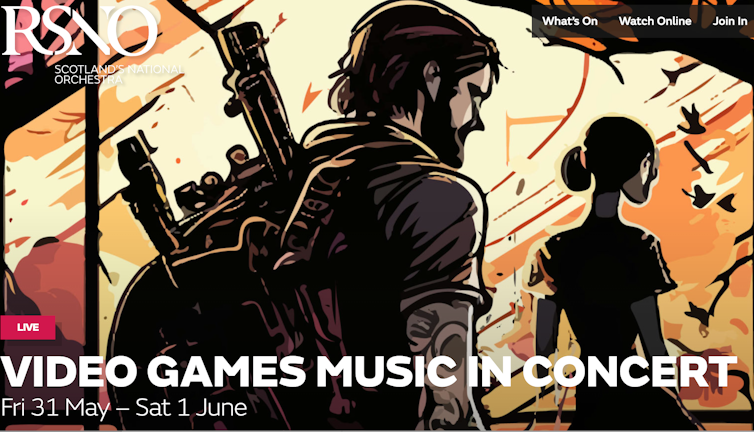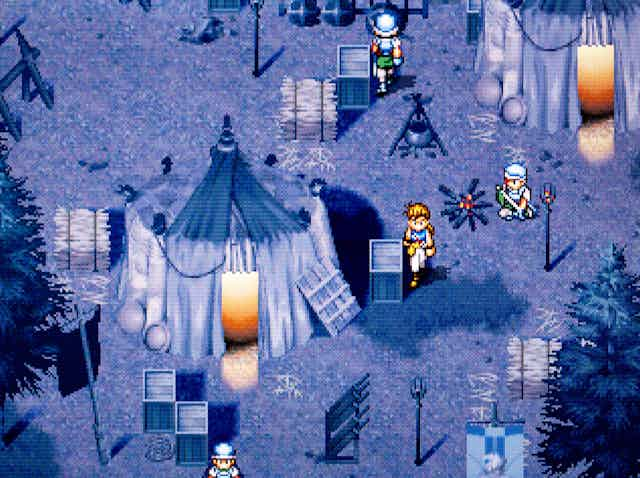One of my clearest musical memories is playing the video game Chrono Trigger on the Super Nintendo in the winter of 1995. When my character first entered the forest where the game is set, I stopped immediately on hearing the musical theme written by the Japanese composer Yasunori Mitsuda. Despite knowing it was a loop, I sat listening for almost an hour, completely transfixed.
The following year I was playing the Sony Playstation game Suikoden – translated from Japanese as Water Margin, which is a loose adaption of the epic Chinese novel of the same name.
Again I stopped when I heard Beautiful Golden City, composed by Miki Higashino. This music affected me so much that it inspired me to begin my own composer’s journey. I wanted to know how this music was made and how I could do something similar.
There are several courses in game audio that include music, such as the one I now teach at Brunel University in London. The academic study of ludomusicology explores the relationship between music and play, and much has been written about the influence of video game music, especially those from the 1990s.
Academics such as KC Collins have documented the history of this medium, and the most recent issue of the Journal of Sound and Music in Games is dedicated to the music of Final Fantasy VII – a game released 26 years ago.
Final Fantasy VII is remembered as the first 3D instalment in the series, as well as for its distinctive use of the PlayStation sound technology by composer Nobuo Uematsu.
Uematsu made several custom synthesised instruments for the soundtrack, as well as utilising sampling technology to record a choir for the final battle cue, One Winged Angel. The game is still popular today, with the second instalment in a trilogy of remakes of the original game is released on February 29.
Strong female influences
Like much of the game world, the music side is a male-dominated arena, but there are a growing number of women swelling the ranks of the industry. Interestingly, the Japanese composers that primarily influenced my love of music are women: besides Higashino, there is Michiru Yamane, Yoko Kanno and Yoko Shimomura.
These four women played a large role in fully immersing me in the game worlds that I explored as a teenager. Kanno is one of the earliest composers who created scores for historical simulation games such as Romance of the Three Kingdoms and Nobunaga’s Ambition in the 1980s, and she became one of the leading anime (Japanese animation) composers from the 1990s to the 2000s.
Shimomura remains at the top of her game, creating scores for the Kingdom Hearts game franchise in addition to dozens of other hit series. Yamane is best known for her Castlevania franchise scores, but has also been working on its spiritual successor, Bloodstained. Higashino retired in the mid-2000s after being a pivotal part of the game developer Konami’s music team, and is best known for her epic music in the first two iterations of the Suikoden franchise.
The UK and Ireland are also rich with astounding female talent in sound and music, and I watch the careers of Alyx Jones, Jade Leamcharaskul and Helen Lynch with great interest.
Game music beyond the game world
The impact of video game music has helped the music industry by creating a new audience for the classical orchestra. Popular concert cover albums of game music have generated dedicated fandoms and conventions, such as the US MAGFest – a large game convention based in Maryland focusing on game music cover artists.

Other US gaming events, such as Video Games Live and Distant Worlds, work with existing orchestras to put on entire game music concerts, and they have often been credited with saving orchestras with sold-out performances.
Big cities such as Washington DC and London are homes to video game orchestras such as the Washington Metropolitan Gamer Symphony Orchestra and the London Video Game Orchestra. There are many popular video game music cover artists such as Lacey Johnson and Ian Martyn performing the time-tested classics.
Besides my work composing music, I am also entering the world of game music performance with a new album of flamenco-styled game music by the Japanese composers who have been my own great influences.
A darker side
Despite flourishing academic study and performance, the commercialisation of games and their music has a more downbeat side. While the industry made record profits in 2023, it saw a record number of layoffs in the very same year, and audio teams are no exception. Additionally, music streaming giant Spotify is limiting profits for artists with a minimum threshold of streams before they are eligible for payment.
However, I am optimistic for the game audio community. New talent is setting wonderful precedents by creating unions and communities such as Game Audio London. Cover labels and promoters such as GameGrooves and Scarlet Moon are helping video game cover artists reach a wider audience.
Organisations such as Video Games Live and Distant Worlds are continuing to tour the globe to sold-out audiences. The field of audio in the games industry creates the soundscapes gamers and fans enjoy, and now it is moving beyond that sphere to take its place in the world of music concerts to reach a wider audience.

